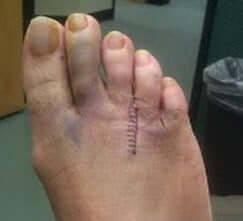Morton’s Neuroma Surgery is usually not recommended due to its high risk and high complication rate

Should I have Morton’s neuroma surgery? (or why shouldn’t I have Morton’s neuroma surgery?)

In some patients Morton’s neuroma surgery is unavoidable because their Morton’s neuroma is resistant to any other means of treatment. However in the vast majority of cases surgery is avoidable. (We only consider surgery for Morton’s neuroma as a last option when all other non-surgical treatments have failed.)
We can effectively treat Morton’s neuroma without surgery, (in many cases more effectively than surgery) and the recovery time from our procedures is only a couple of days.
For more information on the non surgical options we offer to treat Morton’s neuroma, CLICK HERE.
Surgery for Morton’s neuroma is often associated with complications, most commonly post surgical pain. In many cases the post surgical foot pain may be as bad or worse as the foot pain before surgery. Some studies have shown that up to 35% of patients who have surgery end up with unacceptable levels of post surgical pain.
Most first time Morton’s neuroma surgery is done through the top of the foot (the “dorsal” approach) which involves cutting through the the transverse metatarsal ligament. Although this results in a shorter recovery time than operating through the bottom of the foot, it results in more post operative foot instability, with forefoot splaying and potential long term gait problems.

The basic recovery time from Morton’s neuroma surgery is frequently 3 or possibly 4 weeks, even if a top of the foot (“dorsal”) surgical approach is used and it can easily take 3-4 months to for the full effects of surgery. In other words, it can take 3-4 months to become fully mobile.
If another surgery is required, the success rate of a Morton’s neuroma redo surgery is considerably lower than the success rate of a first time Morton’s neuroma surgery. The redo Morton’s neuroma surgery is most commonly done through an incision in the bottom of the foot (the “plantar aspect” of the foot.) This approach results in an even longer and more painful recovery than a regular Morton’s neuroma surgery. It can take 4-6 months of painful recovery to fully recover from a redo Morton’s neuroma surgery.
There are always general surgical risks associated with any surgery and so surgery should always be avoided if possible.
However, in some cases when Morton’s neuroma is resistant to other treatments, surgery is the only option left and is unavoidable.


By providing us with your information you are consenting to the collection and use of your information in accordance with our Terms of Service and Privacy Policy.